The Queen’s clock, part 2.
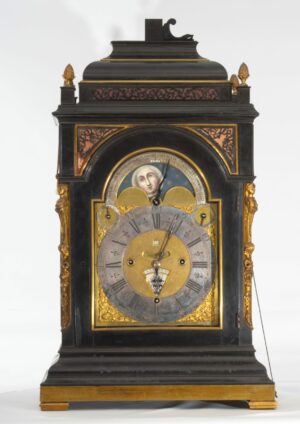
A large and rare Dutch musical table clock from the Dutch Royal collection.
Collection of Queen Juliana
Gude & Meis recently acquired a Dutch table clock which was sold at Sotheby’s Amsterdam in March 2011. The sale consisted of art and objects from the collection of Queen Juliana of The Netherlands. We thought that it would be interesting to share the history, characteristics and restoration of this clock with you in a series of short articles.
The History 2.
Royal provenance
 We know from the picture of Wilhelmina’s drawing room at Palace Noordeinde that our clock actually was there in the 1930’s. But what happened with our clock of Royal Provenance after that period? Queen Wilhelmina of the Netherlands was in exile in London from May 1940 until May 1945. After her return Palace Noordeinde wasn’t used anymore as a residence. Thankfully for us a series of photos was made by the photographer G.J. Dukker in January 1967. On one of those we can catch a glimpse of our clock placed on a table next to an early 17th Century Dutch cupboard. The description reads; ‘Interieur, Paleis Kon. moeder, kast op bovenachterkamer’. (Interior, Palace Queen Mother, cupboard on upper hind room.) Comparing the clock to the substantial cupboard one becomes aware of the large dimensions of the clock.
We know from the picture of Wilhelmina’s drawing room at Palace Noordeinde that our clock actually was there in the 1930’s. But what happened with our clock of Royal Provenance after that period? Queen Wilhelmina of the Netherlands was in exile in London from May 1940 until May 1945. After her return Palace Noordeinde wasn’t used anymore as a residence. Thankfully for us a series of photos was made by the photographer G.J. Dukker in January 1967. On one of those we can catch a glimpse of our clock placed on a table next to an early 17th Century Dutch cupboard. The description reads; ‘Interieur, Paleis Kon. moeder, kast op bovenachterkamer’. (Interior, Palace Queen Mother, cupboard on upper hind room.) Comparing the clock to the substantial cupboard one becomes aware of the large dimensions of the clock.
(photo; beeldbank.nl )
 Thankfully there a following photo that shows the clock in full. Now with the description; ‘Interieur, Paleis Kon. moeder, klok op bovenachterkamer’. ( Interior, Palace Queen Mother, clock on upper hind room.) The term ‘Palace Queen Mother’ refers to the Palace Lange Voorhout. From this we can conclude that the clock was at Palace lange Voorhout in 1967. It must have been at this location where it got it’s inventory number PLV 610. (Paleis Lange Voorhout)
Thankfully there a following photo that shows the clock in full. Now with the description; ‘Interieur, Paleis Kon. moeder, klok op bovenachterkamer’. ( Interior, Palace Queen Mother, clock on upper hind room.) The term ‘Palace Queen Mother’ refers to the Palace Lange Voorhout. From this we can conclude that the clock was at Palace lange Voorhout in 1967. It must have been at this location where it got it’s inventory number PLV 610. (Paleis Lange Voorhout)
(Photo; Beeldbank.nl, with special thanks to Robert Schilten)
Palace Lange Voorhout
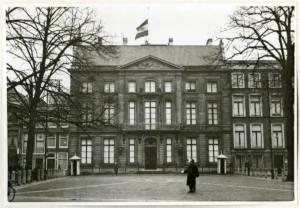 Architect Pieter de Swart built a mansion for Anthony Patras at ‘Lange Voorhout’ in 1764. Sadly Patras, who was a representative for Friesland and the major of Sloten, only enjoyed ‘House Patras’ shortly because he died soon after the completion. After his death the building came into the possession the banker’s family Hope. An interesting fact is that Napoleon Bonaparte lodged in the house for two days during his visit to The Hague in 1811. King William II bought the building in 1845 for one million Guilders from Johan Gijsbert Baron Verstolk van Zoelen. After the purchase ‘House Patras’ became Palace lange Voorhout.
Architect Pieter de Swart built a mansion for Anthony Patras at ‘Lange Voorhout’ in 1764. Sadly Patras, who was a representative for Friesland and the major of Sloten, only enjoyed ‘House Patras’ shortly because he died soon after the completion. After his death the building came into the possession the banker’s family Hope. An interesting fact is that Napoleon Bonaparte lodged in the house for two days during his visit to The Hague in 1811. King William II bought the building in 1845 for one million Guilders from Johan Gijsbert Baron Verstolk van Zoelen. After the purchase ‘House Patras’ became Palace lange Voorhout.
Queen-mother Emma
William II’s youngest son Hendrik lived in the Palace until his death in 1879. His sister Sophie inherited it. Queen-mother Emma bought the palace from her at the end of her second period as Regent and used it as a winter palace until her death in 1934. Wilhelmina also used it as a winter palace after her abdication in 1948. Juliana used the building as a work palace giving it a central position in political and state events.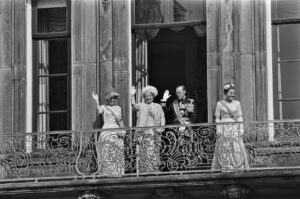 It was for instance, the start- and finish of the ‘Prince day parade’. (Princes day is the start of the political year held every year at the third Tuesday of September). And it also was the stage of many State receptions and presentations of government. After Juliana, Beatrix also used the building as a work palace until in 1984 Palace Noordeinde was ready to take over this function. Although Wilhelmina, Juliana and Beatrix used the palace after Emma, the term Queen mother’s palace stuck informally.
It was for instance, the start- and finish of the ‘Prince day parade’. (Princes day is the start of the political year held every year at the third Tuesday of September). And it also was the stage of many State receptions and presentations of government. After Juliana, Beatrix also used the building as a work palace until in 1984 Palace Noordeinde was ready to take over this function. Although Wilhelmina, Juliana and Beatrix used the palace after Emma, the term Queen mother’s palace stuck informally.
(source; Wikipedia and pictures internet )
https://nl.wikipedia.org/wiki/Paleis_Lange_Voorhout
From Palace Nooreinde to Palace Lange Voorhout
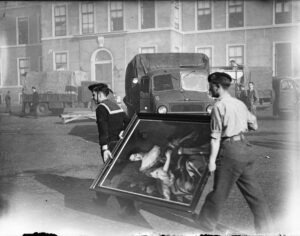 Taking all the facts and information into account it is logical to assume that during Wilhelmina’s exile the clock remained in Palace Noordeinde for the duration of the war. After her return from london it must have moved with her to Palace Lange Voorhout because the clock was her possession. But there is another event that might have had a role in the transit of the clock from Noordeinde to Lange Voorhout. In May 1948 a devastating fire demolished a part of Palace Noordeinde. Service men were called up to salvage as many of the artifacts and art as possible from the building. It is not unlikely that the clock was salvaged from Noordeinde and got placed at Lange Voorhout out of necessity.
Taking all the facts and information into account it is logical to assume that during Wilhelmina’s exile the clock remained in Palace Noordeinde for the duration of the war. After her return from london it must have moved with her to Palace Lange Voorhout because the clock was her possession. But there is another event that might have had a role in the transit of the clock from Noordeinde to Lange Voorhout. In May 1948 a devastating fire demolished a part of Palace Noordeinde. Service men were called up to salvage as many of the artifacts and art as possible from the building. It is not unlikely that the clock was salvaged from Noordeinde and got placed at Lange Voorhout out of necessity.
(photos; https://commons.wikimedia.org/)
Cultural destination
Prinses Juliana sold the Palace Lange Voorhout in 1990 to the city of The Hague under the condition that the building should receive a ‘cultural destination’. In 1992, after the palace had been extensively renovated, a number of exhibitions were held. This was done until 2002 when the Palace became the museum ‘Escher in the Palace’ devoted solely to the graphic art of M.C. Escher.
(source; wikipedia)
Royal attic
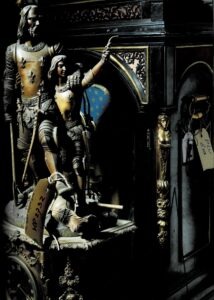 After the Palace Lange Voorhout was sold in 1990 the clock probably transferred to a storage. It is unlikely that the clock was placed in one of the Royal palaces when we look at the unrestored condition of the clock. Maybe it was a Royal attic as we romantics would love to imagine. But it just could have been a modern storage facility where it was kept until the auction in 2011. The photo here was published in the catalog as a romantic atmospheric image of the storage situation.
After the Palace Lange Voorhout was sold in 1990 the clock probably transferred to a storage. It is unlikely that the clock was placed in one of the Royal palaces when we look at the unrestored condition of the clock. Maybe it was a Royal attic as we romantics would love to imagine. But it just could have been a modern storage facility where it was kept until the auction in 2011. The photo here was published in the catalog as a romantic atmospheric image of the storage situation.
In following posts we will share more on this interesting and important clock.
Text; Jos Meis
